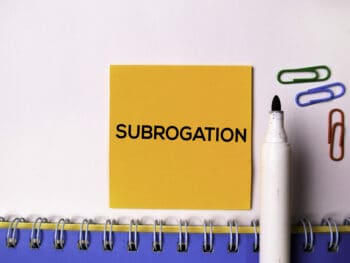
But what if the injury happened due to some other outside force? Maybe an outside vendor an employer uses from another company is walking through the halls cleaning or waxing the floor and failing to place signs to not walk in that area. And a worker falls and fractures an arm. What to do then?
There are a lot of varying factors and legal issues in the world of subrogation that vary from state to state. But, it is worth exploring some sort of recovery to recoup medical expenses and wage loss paid. Subrogation should be explored in every claim, even if it seems the injury was due to a simple “employee operation error.”
Click Link to Access Free PDF Download
“How Do I Get My Adjusters To Follow My Account Handling Instructions?”
What is Subrogation?
Subrogation is the right for an insurer to pursue a third party that caused an insurance loss to the insured. This is done as a means of recovering the amount of the claim paid to the insured for the loss.
When a new claim is received from a slip or fall, the first question to ask is where the accident occurred. Let us say this happened in a parking lot of the employee’s workplace. Why did the employee fall? Was it snowing? Was the lot plowed and salted properly if the fall was in the winter? Was it plowed previously then more snow accumulated? Did any other employees fall or notice slippery conditions?
This is most important when having an outside vendor that is hired to maintain the outside premises during the winter months. If this is the case, then there may be a subrogation claim to pursue. If the outside vendor had a duty to maintain the premises and failed to do so, then it can be argued depending on the jurisdiction.
Now say that an employee fell in a hallway or in a bathroom. Was an outside vendor onsite to wax or clean the floors and forgot to wipe up some water that caused the employee to fall? Was the area roped properly with warning signs? Where were the signs located? Did anyone else see the signs? Again, if a maintenance contract exists with this company, there is a claim to pursue. Winning subrogation claims can mean that the outside vendor pays the employer back expenses to get the worker back to full duty.
There are many employers that choose to use outside vendors for this specific reason — to shift the risk to an outside vendor. Any failure to properly mark areas as being worked on or being “wet” can result in the pursuit of a subrogation claim. The same goes for parking lots and sidewalks. Some vendors will allow employers to list demands for winter care when the need for salting, sanding, and snow arrives. The employer can be as rigid as preferred (with some vendors) and this way if an injury does occur, the expense shifts to the other carrier rather than incurring the total cost of the medical and wage expenses under the employer’s carrier. Every carrier usually has a subrogation unit to pursue injuries.
- Tripping over something
Did an employee fall over a mat that was not placed down properly? Did a worker stumble and fall due to a rug or placemat that had holes in it or it was not in proper working/functioning order? Again, using an outside vendor to maintain these areas and rugs can help if an injury occurs. These vendors have a duty to properly place the rugs or mats, and these floor coverings have to be in proper working order. Now it can be asked, “How can a rug not be in proper working order?” If a rug is down on the floor, it is in working order. But, maybe these rugs are old and worn out in certain areas, and therefore they are not as productive as they should be. They are ineffective for the purpose. Employers use entry and exit rugs and carpets, relief mats in front of machines, anti-slip strips on steps, etc. If any of these are in disrepair or appear in poor shape, and an injury occurs, it could be a subrogation claim. This vendor may be responsible for failing to replace these worn items, again shifting the risk and expense from you the employer to them.
- Machinery injuries and Mechanical failures
When there is a claim where a person gets injured while using a machine, the manager will usually say that the employee was not paying attention when the injury occurred. This may be true, but also machine manufacturers have a duty to design proper, safe equipment. Sometimes machines have design flaws and can lead an injury. Maybe there should be a guard in a certain area where there is not one, a hand can reach an area it should not be able to reach, or the machine does not turn off all the way, even though the switch is turned fully to the offsetting. All of these issues can result in injury and the company that makes the machine can be held responsible. This will involve the carrier bringing a machine expert, or engineer, but it can be worth the cost, especially in a severe injury.
Do not be so quick to point out operator error as the sole cause of an injury involving a machine. The operator may have made a mistake, but the problem may stem from deeper design issues.
- Vehicle Accidents
In certain states, the driver that causes an accident can be held liable. The worker may have been doing nothing wrong other than driving down the road when another vehicle slammed into the vehicle from behind. Maybe the vehicle that hit the employee’s vehicle is from another company. Even though the van may not be marked as a commercial van, it still could be a business van used for company purposes. Who owns this vehicle that hit the employee? What was the driver doing? Where were they going, and why did the accident occur? Motor vehicle accidents can be severe. If there is subrogation in a vehicle case, a thorough investigation is worthwhile.
- Injuries from other vendors on your premises
If a vendor is on the premises conducting normal business, and an injury happens, there could be subrogation potential. Maybe the cart slid away and hit the employee. Maybe a vehicle or other mode of transportation on the job site was being used, lost control, and hit another worker, or the vendor was unloading supplies in the back area and while stacking boxes, and the boxes landed on the employee. The subrogation unit will determine if this vendor is responsible for the injury, and they could have to reimburse you, the employer, for the cost to heal an injured worker.
Summary
Subrogation investigations and claims can come from injuries where employers least expect, and there are many different circumstances that caused the injury. Talk with the carrier about subrogation and if the carrier has a unit dedicated to only subrogation investigations and the pursuit of subrogation claims. It can save a substantial amount of claims expense, especially on those severe injuries. The subrogation department should be reviewing every injury to see if a claim can be pursued. And every claim pursued could yield the employer reimbursement from another carrier.
 Author Michael Stack, CEO Amaxx LLC. He is an expert in workers’ compensation cost containment systems and helps employers reduce their workers’ comp costs by 20% to 50%. He works as a consultant to large and mid-market clients, is a co-author of Your Ultimate Guide To Mastering Workers Comp Costs, a comprehensive step-by-step manual of cost containment strategies based on hands-on field experience, and is the founder & lead trainer of Amaxx Workers’ Comp Training Center, which offers the Certified Master of Workers’ Compensation national designation.
Author Michael Stack, CEO Amaxx LLC. He is an expert in workers’ compensation cost containment systems and helps employers reduce their workers’ comp costs by 20% to 50%. He works as a consultant to large and mid-market clients, is a co-author of Your Ultimate Guide To Mastering Workers Comp Costs, a comprehensive step-by-step manual of cost containment strategies based on hands-on field experience, and is the founder & lead trainer of Amaxx Workers’ Comp Training Center, which offers the Certified Master of Workers’ Compensation national designation.
Contact: mstack@reduceyourworkerscomp.com.
Workers’ Comp Roundup Blog: http://blog.reduceyourworkerscomp.com/
©2021 Amaxx LLC. All rights reserved under International Copyright Law.
Do not use this information without independent verification. All state laws vary. You should consult with your insurance broker, attorney, or qualified professional.







